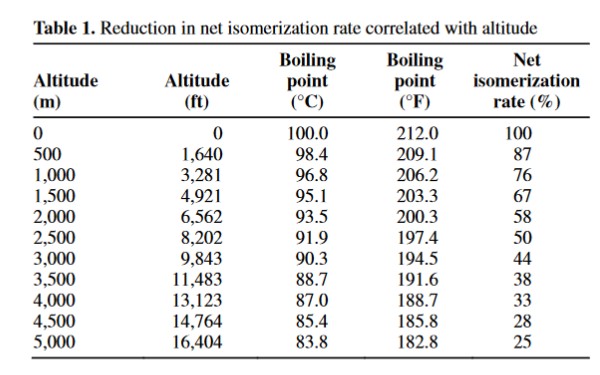From Vol. 1, No. 7, February 2018
John Palmer, author of How to Brew and now publications director for the Master Brewers Association of the Americas, went to Peru and this happened.
“A Look at Isomerization Reduction Due to Altitude” in the MBAA Technical Quarterly (Vol. 54, No. 3) includes a chart pretty certain to scare the poop out of anybody making beer a mile or more above sea level.

© 2017 Master Brewers Association of the Americas. Reproduced, by permission, from Palmer, J. 2017. A look at isomerization reduction due to altitude. Tech. Q. 54(3):120-22. doi.org/10.1094/TQ-54-3-0806-01
Palmer writes: “In February 2017 at the Copa Latinoamericana de Cervezas Artesanales in Yucay, Peru, the judges noticed that several entries in the India pale ale (IPA) categories often lacked the bitterness level that is characteristic of the style. The entries were well-brewed, but the perceived bitterness was characterized as being more appropriate for a pale ale style rather than for IPA. While no measurements were available to corroborate this perception, the judges were all experienced and generally agreed that the perceived bitterness was generally in the range of 20–40 BU rather than the more typical 40–60 BU range for IPA.
“Discussion with many of the brewers present at the competition revealed that many of their breweries were at high altitude; for example, the elevation of Sacred Valley Brewery in Pachar, Peru, is about 9,500 ft (2,961 m), and many were higher. This prompted a discussion about the loss in isomerization due to decrease in boiling point with altitude.”
The chart is based on a model first published in 2005 by M.G. Malowicki and Thomas Shellhammer. The numbers look pretty dramatic, particularly once you reach the altitude of Albuquerque, N.M., or Denver. However, and Palmer makes this point several times in the article, while isomerized hops are most often the largest contributor to bitterness they are not the only one.
Additionally, many other variables change utilization, including the obvious (kettle geometry; the difference between a five-gallon homebrew system and even a 10-barrel commercial brewery is startling) and not so obvious (composition of the humulones).
The paper concludes: “Overall, boiling hops at high altitude, and therefore a lower boiling temperature, will result in less isomerization than the same hop addition boiled at sea level, all else being equal. Therefore, the overall hop bitterness of the beer will be less than may have been intended, assuming the hop additions had been calculated without regard to the effect of altitude.
“Brewers at high altitude may want to consider buying preisomerized hop extract and using that for the majority of the beer’s bitterness and save their hops for aroma additions after the boil when the isomerization loss is not a factor.”